Journal publications
HyFiSyn aims to train 13 early stage researchers to become interdisciplinary, multi-talented experts. The 8 universities, 5 industrial partners and 2 professional training organisations offer the researchers a unique opportunity to be trained by world-leading experts in cutting-edge technologies, where they are supported by a strong network and industry participation. The training programme strongly emphasises entrepreneurship and innovation skills to maximise the impact of the project, thereby increasing the EU’s innovation capacity.
If you are interested to obtain a PhD within this project, then please fill out the application form and make sure to include CV, motivational letter and transcripts. For the files to be uploaded, please stick to PDF or Word documents or ZIP-archives thereof. If you have any problem uploading large files, then please send them in a separate email to the project coordinator (yentl.swolfs@kuleuven.be).
Don't forget that you can apply for several positions at the same time by using the tickboxes. If you want to do this, it's best to apply for those positions simultaneously. If you want to use a different cover letter for each position, then please include all of them in a single application.
Journal publications
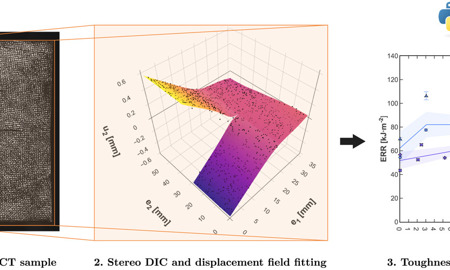
Implementation and parametric study of J-integral data reduction methods for the translaminar toughness of hierarchical thin-ply composites [OPEN ACCESS]
Guillaume Broggi, Joël Cugnoni, Véronique Michaud
Three different J-integral formulations to derive the experimental translaminar toughness of composites from compact tension tests with a large-scale fracture process zone are implemented and discussed. They improve the existing approaches by taking advantage of stereo-digital image correlation to acquire full-field displacement fields. A field fitting procedure based on robust and efficient piecewise cubic smooth splines addresses noise-related issues reported in previous studies. Additionally, the paper proposes a novel crack tip extraction procedure to report the energy release rate as a function of the crack increment, even if knowledge of the crack tip is not required for the proposed J-integral method. The three methods are discussed in light of a parametric study conducted on synthetic and experimental data, including artificially noisy data. The study reveals that the proposed J-integral methods are suitable for translaminar toughness evaluation of a wide range of materials without the need for restrictive assumptions. However, variations in propagation values were observed when applied to experimental data. Finally, guidelines are drawn to chose the most suitable parameters for the algorithms that are proposed as a Python package.
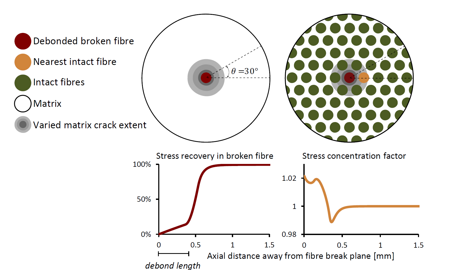
Longitudinal debonding in unidirectional fibre-reinforced composites: Numerical analysis of the effect of interfacial properties
Sina AhmadvashAghbash, Christian Breite, Mahoor Mehdikhani, and Yentl Swolfs
Longitudinal fibre-matrix debonding is governed by interfacial strength, fracture toughness, thermal residual stresses, friction, and matrix plasticity. The proposed finite element model for fibre-matrix longitudinal debonding associated with fibre breakage accounts for these features, retrieving more realistic results for the stress redistribution around a fibre break. In contrast with the majority of the available finite element models, the current model does not impose the debond length and enables debond propagation based on the assigned interfacial properties. Several parametric studies have been performed to assess the effect of input parameters in two configurations: single- and multi-fibre packings. Higher values for interfacial friction coefficient, thermal residual stress and interfacial fracture toughness restrain the debond propagation and consequently accelerate the stress recovery. Conversely, including matrix plasticity facilitates the debond propagation. A prescribed matrix crack, concentric with the broken fibre and as large as thrice the fibre radius, has no significant effect on the extent of the debond but increases the stress concentration on the nearest intact fibres in the multi-fibre model. The results of the proposed finite element model match the reported laser Raman spectroscopy literature data. The current study improves the prediction capability of models for the longitudinal tensile failure of unidirectional composites.
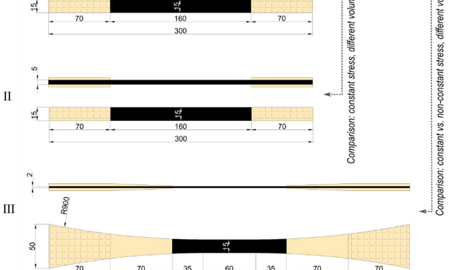
Influence of Test Specimen Geometry on Probability of Failure of Composites Based on Weibull Weakest Link Theory
Rajnish Kumar, Bo Madsen, Hans Lilholt and Lars P Mikkelsen
This paper presents an analytical model that quantifies the stress ratio between two test specimens for the same probability of failure based on the Weibull weakest link theory. The model takes into account the test specimen geometry, i.e., its shape and volume, and the related non-constant stress state along the specimen. The proposed model is a valuable tool for quantifying the effect of a change of specimen geometry on the probability of failure. This is essential to distinguish size scaling from the actual improvement in measured strength when specimen geometry is optimized, aiming for failure in the gauge section. For unidirectional carbon fibre composites with Weibull modulus m in the range 10–40, it can be calculated by the model that strength measured with a straight-sided specimen will be 1–2% lower than the strength measured with a specific waisted butterfly-shaped specimen solely due to the difference in test specimen shape and volume.
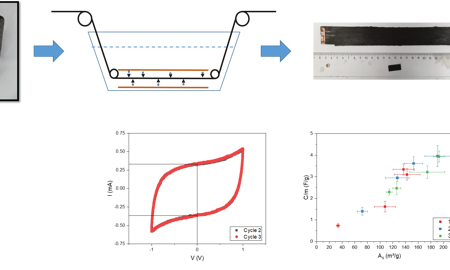
Towards separator-free structural composite supercapacitors
Olivier Hubert, Nikola Todorovic, Alexander Bismarck
Structural supercapacitors can both carry load and store electrical energy. An approach to build such devices is to modify carbon fibre surfaces to increase their specific surface area and to embed them into a structural electrolyte. We present a way to coat carbon fibres with graphene nanoplatelets by electrophoretic deposition in water. The effect of time and voltage on the mechanical properties of the carbon fibres, the structure of the coating and the specific surface area of the coated carbon fibres are discussed. A specific capacity of 1.44 F/g was reached, which is 130% higher than state-of-the-art structural electrodes. We demonstrate the scalability of the deposition process to continuous production of coated carbon fibres. These carbon fibre electrodes were used to realise large (21 cm long) structural supercapacitor demonstrators without the need for a separator, having a specific capacity of 623 mF/g.
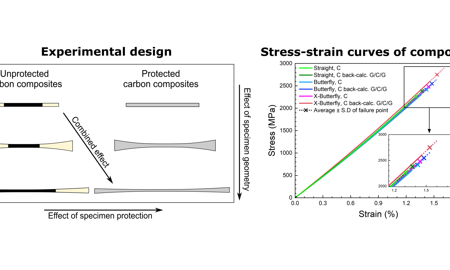
Experimental Method for Tensile Testing of Unidirectional Carbon Fibre Composites Using Improved Specimen Type and Data Analysis
Rajnish Kumar, Lars P Mikkelsen, Hans Lilholt and Bo Madsen
This paper presents an experimental method for tensile testing of unidirectional carbon fibre composites. It uses a novel combination of a new specimen geometry, protective layer, and a robust data analysis method. The experiments were designed to test and analyze unprotected (with conventional end-tabs) and protected (with continuous end-tabs) carbon fibre composite specimens with three different specimen geometries (straight-sided, butterfly, and X-butterfly). Initial stiffness and strain to failure were determined from second-order polynomial fitted stress–strain curves. A good agreement between back-calculated and measured stress–strain curves is found, on both composite and fibre level. For unprotected carbon composites, the effect of changing specimen geometry from straight-sided to X-butterfly was an increase in strain to failure from 1.31 to 1.44%. The effect of protection on X-butterfly specimens was an increase in strain to failure from 1.44 to 1.53%. For protected X-butterfly specimens, the combined effect of geometry and protection led to a significant improvement in strain to failure of 17% compared to unprotected straight-sided specimens. The observed increasing trend in the measured strain to failure, by changing specimen geometry and protection, suggests that the actual strain to failure of unidirectional carbon composites is getting closer to be realized.
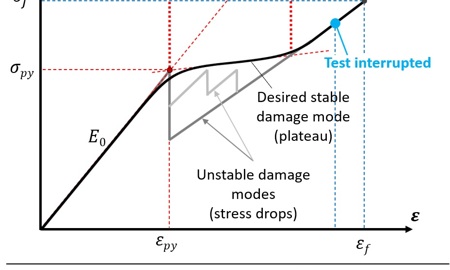
Improving the performance of pseudo-ductile hybrid composites by film-interleaving [OPEN ACCESS]
Salvatore GiacomoMarino, GergelyCzél
Improvement of the interfacial fracture toughness of the layer interfaces is one way to increase the performance of interlayer hybrid laminates containing standard thickness carbon/epoxy plies and make them fail in a stable, progressive way. The layer interfaces were interleaved with thermoset 913 type epoxy or thermoplastic acrylonitrile–butadienestyrene (ABS) films to introduce beneficial energy absorption mechanisms and promote the fragmentation of the relatively thick carbon layer under tensile loads. Carbon layer fragmentation and dispersed delamination around the carbon layer fractures characterised the damage modes of the epoxy film interleaved hybrid laminates, which showed pseudo-ductility in some cases. In the ABS film interleaved laminates, a unique phase-separated ABS/epoxy inter-locking structure was discovered at the boundary of the two resin systems, which resulted in a strong adhesion between the fibre-reinforced and the thermoplastic layers. As a result, the delamination cracks were contained within the ABS interleaf films.
